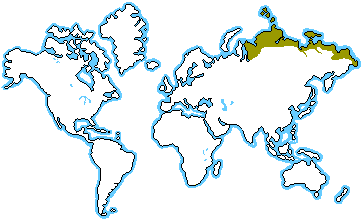

Plants Animals Climate The tundra is
located at the top of the northern hemisphere in Europe,
Asia and North America. It covers 20% of the earth's surface
just below the polar cap. The Siberian Tundra is located in
the northeastern part of Russia between 60° to 80°
North latitude, and 70° to 180° East longitude.
In the tundra,
winters are long and summers are short. During the winter
temperatures are usually below freezing and the ground is
covered with snow and ice. Summers are marshy from puddles
called thermokarsts formed from melted snow and ice. The
Lena, Ob and Yenisei are all permanent rivers that flow into
the Siberian Tundra. Pingoes are formed from pools of water
freezing under the ground and pushing the ground up into a
hill. Some pingoes are 3 to 300 feet tall and a half mile
wide. The tundra is
located 1,000 to 4,000 feet above sea level. In the tundra,
there are two levels of soil. The first layer is called the
active layer because it freezes and thaws. It is 10 inches
to 3 feet deep. The second layer is called the permafrost.
It stays frozen throughout the winter and summer. The
permafrost in Russia can be as deep as 1,968 feet.
The climate in the
Siberian Tundra in the winter is very cold. The temperature
may reach -40 degrees Fahrenheit. Summers are cool with
temperatures of 37 degrees to 54 degrees Fahrenheit.
Precipitation is only 6 to 10 inches per year including
melted snow. The tundra is very
windy. It has winds from 30 to 60 miles per hour. The
windchill is so bad in the tundra, bare skin can freeze in
30 seconds. The plants of the
Siberian Tundra include fungus, grasses and shrubs growing
low to the ground to be protected from the wind and the
cold. They group together to keep warm. Plant roots spread
out on the surface to take in water. They don't grow deep
because the soil is always freezing and thawing which breaks
up roots. One of their adaptions to the cold climate is tiny
hairs on their leaves to help keep in moisture. The animals of the
tundra include fish, birds, mammals and insects. The animals
survive with extra fat and thick fur to keep them warm. Most
animals are low to the ground and their arms, legs, tails
and ears are small to keep from losing heat. Hundreds of
types of birds stay for the summer only. The Yakut people
inhabit the northeastern part of Siberia. To survive, they
hunt, trap and fish animals. Ruts from trucks
have caused the permafrost to melt and some of those areas
have become as large as lakes. There has been lots of
pollution from mining. More people are moving to the tundra,
which creates more waste. Because of the cold weather, the
waste does not break down. With the permafrost frozen solid,
they can not bury the waste either. With the rising
temperature from global warming, the permafrost may begin
melting which will cause flooding to the tundra. This could
destroy the world's greatest biome. In the tundra,
animals are being over hunted with guns. Many animals are
being hunted almost to extinction. Now there is a limit to
how many animals can be killed in one year. In Russia, areas of
land have been set aside for national parks. These parks
will protect the wildlife and the tundra. There are now ways
to build highways across the tundra without damaging the
permafrost. By Evan S. 2002
bibliography: Kaplan, E. (1996).
Tundra. Tarrytown, NY: Benchmark Books Weigel, M. (2000).
Encyclopedia of Biomes. M.I: U.X.L. Albert, W. (1972).
The Life of the Far North. United States:
McGraw-Hill, Inc. "Wildlife Of the
Artic Tundra" Wildlife Explorer, Card 8,
International Masters Publishers USA, 1998. "The World's Biomes:
Tundra" http://www.ucmp.berkeley.edu/glossary/gloss5/biom/tundra.html
"Map Quest : World
Atlas", http://www.mapquest.com/atlas/?print=asia.
(Nov. 2001)
(Nov. 2001)
|
|
|
|
|